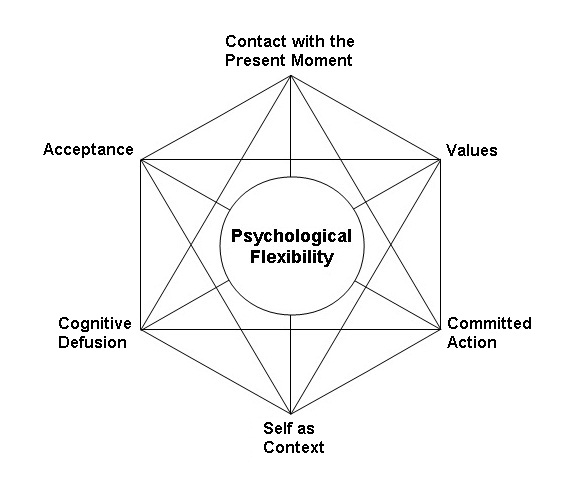Acceptance and Commitment Therapy (ACT) is an empirically supported psychological intervention that evolved alongside Relational Frame Theory (RFT) and is part of Contextual Behavior Science (CBS).
ACT is one of the third generation of behavioural and cognitive therapies. Within this framework, the operant-behavioral generation came first followed by the cognitive-behavioural perspective. More recently a number of therapies, such as ACT, have promoted a more ‘contextual’ approach. In the same way that the cognitive-behavioural generation built on the operant-behavioral, so contextual approaches share features with both predecessors. But along with significant similarities there are also subtle but important differences. For example, rather than trying to alter the ‘form’ of thoughts, as traditional cognitive-behavioural approaches might advocate, contextual approaches are more interested in their ‘function’.
Imagine the thought: ‘I am worthless’. Both cognitive-behavioural and contextual approaches may notice a relationship between the occurrence of thought and certain behaviours. For instance the thought may co-exist with an individual being less social, comfort eating, even self-harming. Both approaches may attempt to address aspects of the thought, but perhaps in different ways.
Cognitive-behavioural approaches may see the ‘form’ of the thought as a problem. The thought may be labelled as negative or maladaptive and its content may be challenged or disputed. Part of therapy may involve altering the content of the thought from ‘I am worthless’ to ‘I am not worthless’. Behind this work may be an assumption that if the original thought no longer occurred then it would no longer be able to influence behaviour.
Conversely, contextual approaches do not see thoughts as problematic as a result of their ‘form’ alone but as a result of their ‘function’. Accordingly ACT would try to alter the function of the thought. In other words, rather than trying to stop the thought occurring or changing its content, ACT might try to change the relationship between the thought and behaviour. In the end, the thought ‘I am worthless’ might continue to occur but without resulting in the behaviours described above. In short, ACT interventions do not aim to stop difficult thoughts or feelings taking place but instead to foster a flexibility that allows individuals to both experience such events and to freely direct behaviour towards that which matters most.
ACT processes

The key processes of ACT are often illustrated using a variation of the diagram above known as the ‘hexaflex’. At the heart of this diagram and at the core of the ACT is the notion of ‘psychological flexibility’. This describes an ability to respond in a flexible way to unfolding psychological events. Such flexibility allows one to maintain or modify behaviour according to that which is personally important and the opportunities available in the present moment. Contributing to levels of psychological flexibility are six inter-connected processes that are briefly defined in the table below.
| Process | Definition |
|---|---|
| Acceptance | A continuing willingness to experience difficult thoughts, feelings, body sensations, and memories without defence |
| Cognitive defusion | An ability to watch and observe thoughts without being unnecessarily dominated or ruled by them |
| Self as context | A perspective on self that is unchanged by time or experience |
| Contact with the present moment | An ability to be aware of how thoughts often have a past or future quality and to be able to more frequently connect with the present |
| Values | The clarity and capacity to follow what is most personally important |
| Committed action | Sustained, sustainable, and flexible behaviour in the direction of values |
| Adapted from Thompson and McCracken (2011) |
It is important to be aware that the processes that make up the hexaflex are ‘mid-level terms’ and as such should be ‘held lightly’. Remember ACT evolved alongside the psychological account of human language and cognition provided by Relational Frame Theory (RFT). As data from RFT provides further insights it is likely that these mid-level terms will be further revised. So as wider Contextual Behavior Science (CBS) develops we can expect the hexaflex and the processes within it to be refined.
The evidence base for ACT is growing. As of October 2020 over 400 randomised control trials (RCTs) involving ACT had been published or were in press. See the list here. In certain areas, such as Chronic Pain, ACT has been classified as having a strong evidence base. While much of the research has been conducted in areas such a mental health, ACT is also used in other areas of human functioning such as work place settings. One recent review of the ACT evidence base is available here.
There is more information about ACT on this website, for example you can download a short introductory article here. However the best resource for online ACT information is the official website of the Association for Contextual Behavioral Science (ACBS). This provides an evolving, global, online resource for those interested in ACT, RFT and other aspects of CBS.